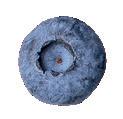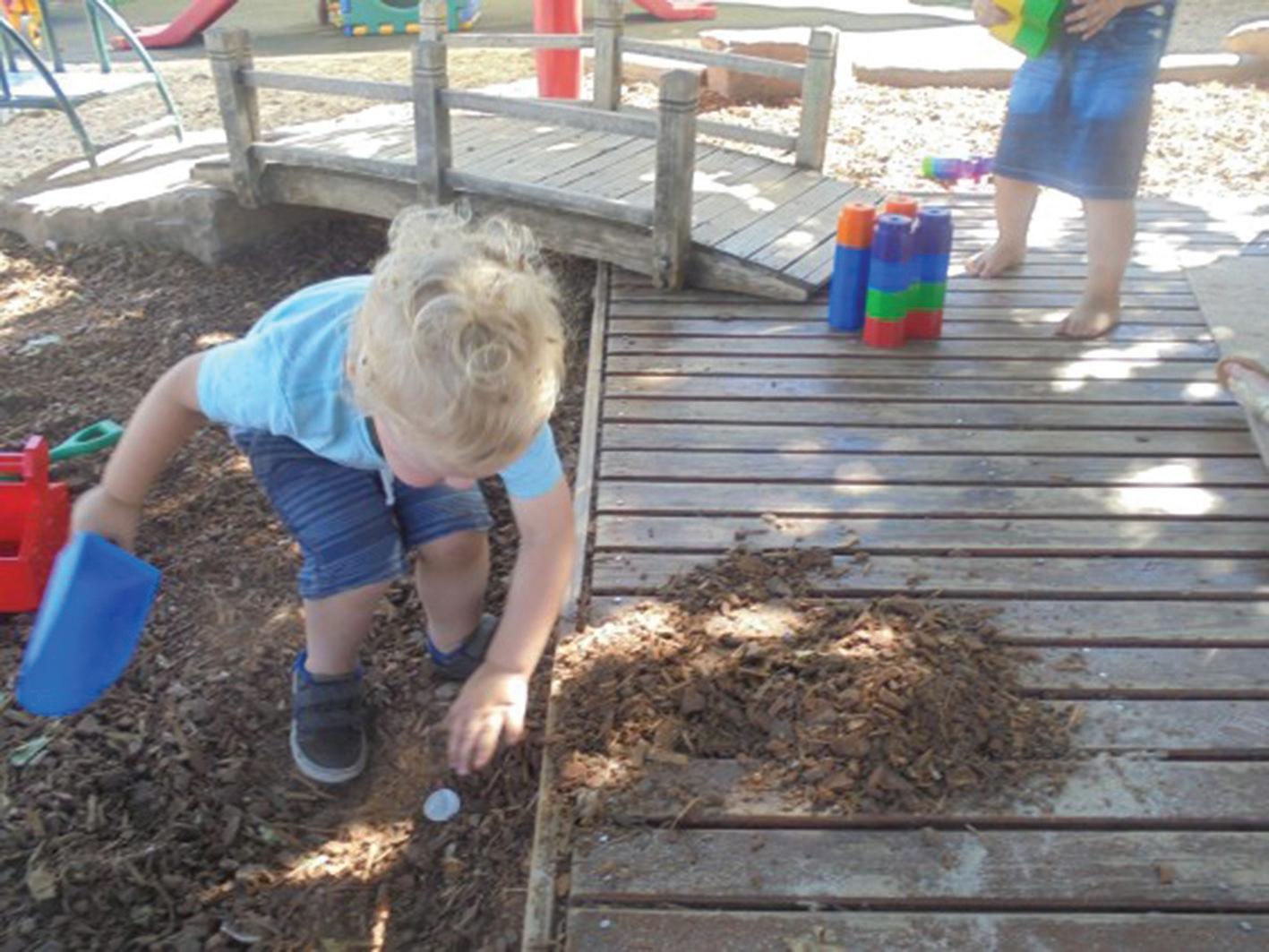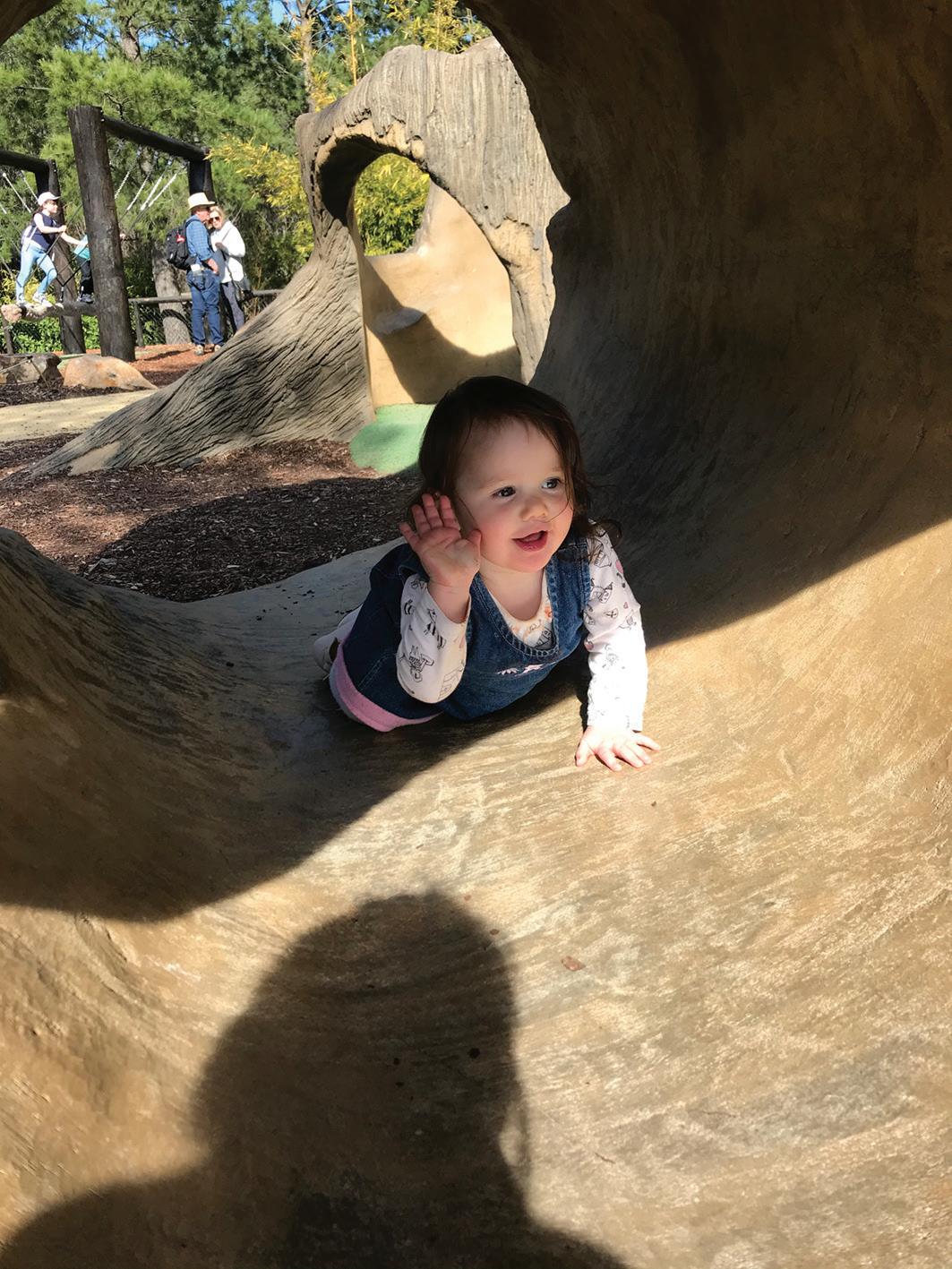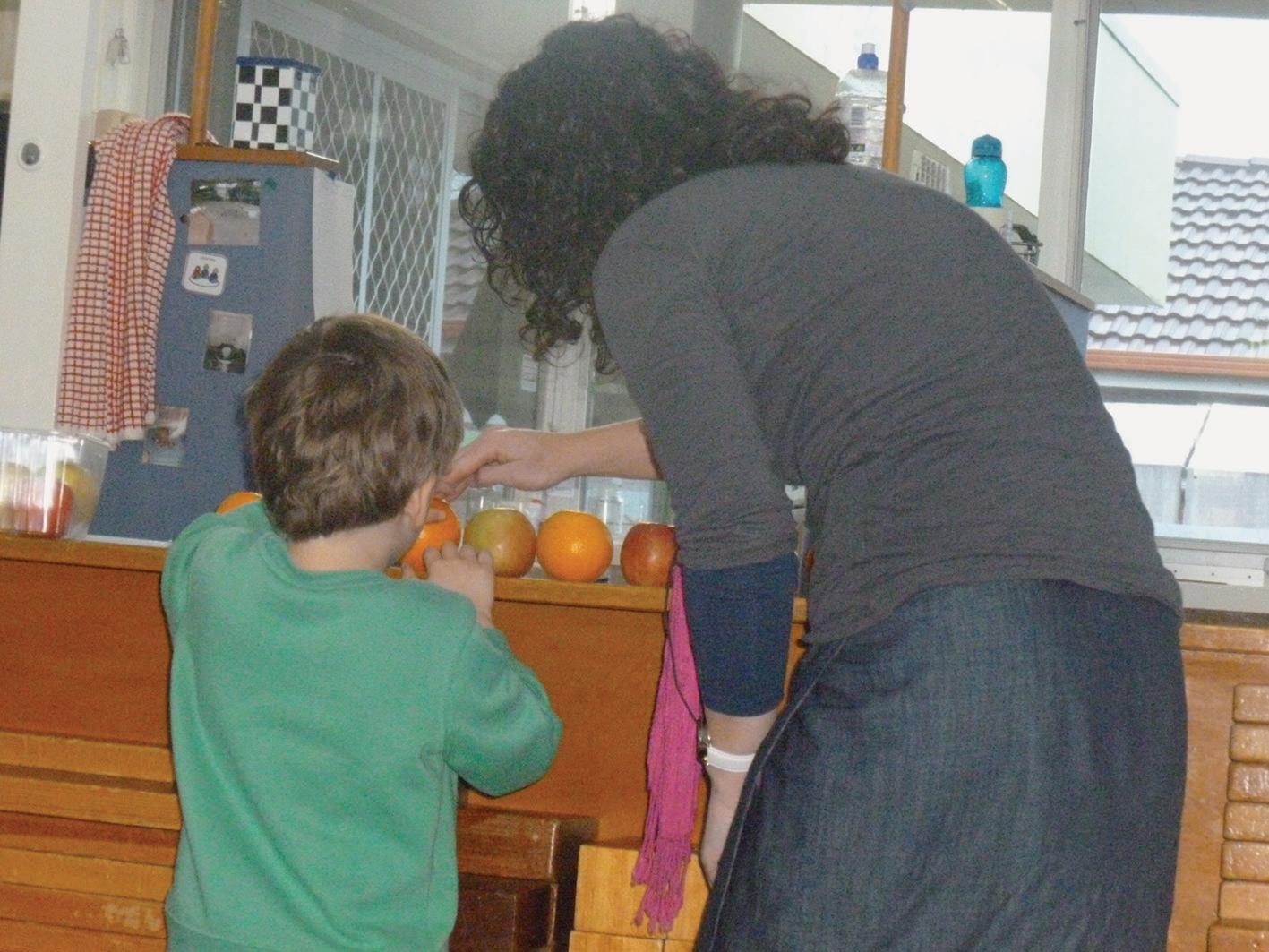OxfordUniversityPressSampleOnly


38756_MAC_MECE_TXT_PPS_NG.indb 1 27-May-23 20:47:39
Learn more Go online to see a video from Paige Lee explaining the key messages of this chapter.
CHAPTER OVERVIEW
This chapter will provide an overview of early childhood mathematics education and will justify the importance of exploring mathematics in the early childhood years. The chapter begins by outlining the body of research that provides evidence for young children’s mathematical competence. It then considers what might be meant by ‘early childhood mathematics education’ and concludes with a useful framework for exploring mathematics in the everyday lives of young children.
In this chapter, you will learn about the following topics:

» views of mathematics
» mathematics and numeracy
» early childhood mathematics education
» young children’s mathematical competence
OxfordUniversityPressSampleOnly
» noticing, exploring, and talking about mathematics.
KEY TERMS
» Early childhood
» Early childhood mathematics education
» Mathematics
» Noticing
» Numeracy
OXFORD UNIVERSITY PRESS 01
Introduction
38756_MAC_MECE_TXT_PPS_NG.indb 2 27-May-23 20:47:41
There is growing recognition that children explore a range of mathematical ideas from a very young age. Researchers used to think that very young children have very little knowledge of, or capacity to learn, mathematics; however, contemporary research argues that mathematical competencies are either innate or develop in the first years of life (Sarama & Clements, 2009). Furthermore, it has been suggested that the increasing numbers of children participating in early childhood programs, and the growing recognition of the importance of mathematics in general, provide compelling reasons for understanding children’s mathematical development in the early childhood years (Doig, McRae, & Rowe, 2003). In this first chapter, I lay the foundations for the importance of mathematics education in the early childhood years. This book adopts the definition of early childhood as being the period from birth to eight years of age and considers children’s learning within and across a range of settings, including early childhood education and care, early primary school, and home and community contexts. With this in mind, in this book early childhood mathematics education can be taken to mean the opportunities for learning about mathematics, both formally and informally, across the range of contexts in which young children participate. Both early childhood and school settings are considered, as are the specific curricula that relate to these settings. However, the book is written with the intention of being relevant to educators across both of these settings without being specific to one or the other. Indeed, it is important to consider mathematics education across the transition to school in terms of both continuity and change; hence, the content of this book might be relevant to prior-to-school settings or school settings or both equally and at the same time.
Throughout this book, ‘Curriculum Connections’ features provide links between chapter content and the two curricula guiding early children’s mathematics education in Australia: Belonging, Being and Becoming: The Early Years Learning Framework for Australia (EYLF; Australian Government Department of Education and Training [DET], 2019); and the Australian Curriculum: Mathematics (Australian Curriculum, Assessment and Reporting Authority [ACARA], 2022). These features are intended as a guide for how the mathematical content and pedagogical approaches explored in this text align to the curricula with which early years educators work. It is anticipated that these links will assist you to engage with curricula in meaningful ways and will serve as a model for linking your own pedagogical practices to appropriate curricula and other frameworks that guide your teaching practice.
Views of mathematics
‘Mathematics’ is a term that may be taken for granted; however, it is usually the case that people have differing definitions of—and differing views of what constitutes—mathematics. It is likely that people’s individual experiences of mathematics will in large measure account for these differences. Some people view mathematics as a body of ‘universal truths’ that teachers transfer or impart to their students as a set of facts and skills; while others view mathematics as a socio-cultural practice that is a product of reflective human activity (Siemon et al., 2011).
Our views of what constitutes mathematics shape our decisions about how we teach and learn mathematics (Siemon et al., 2011):
If mathematics is viewed as a set of universal truths, teachers are more likely to see their task as transferring a given set of facts and skills to students and to view
Early childhood is defined as the period from birth to eight years of age.
Early childhood mathematics education refers to the opportunities for learning about mathematics across the range of contexts in which young children participate.
Mathematics is a knowledge domain that is about patterns, relationships, representations, symbols, abstraction, and generalisations.
3 AMY MACDONALD OXFORD UNIVERSITY PRESS CHAPTER 01 In TRO du CTIO n
Introduction
“ 38756_MAC_MECE_TXT_PPS_NG.indb 3 27-May-23 20:47:41 OxfordUniversityPressSampleOnly
Pause and reflect
student learning as the capacity to reproduce these facts and skills as instructed. If, on the other hand, mathematics is viewed as a socio-cultural practice, a product of reflective human activity, then it is more likely that teachers will see their task as engaging students in meaningful mathematical practices and view student learning in terms of conceptual change (p. 6).
What is your view of mathematics? Do you see it as ‘universal truth’, ‘socio-cultural practice’, or a combination of the two? How does your view influence your ideas about mathematics teaching and learning?
Across the contemporary mathematics education literature and curriculum documents, a typical definition is that mathematics is a discipline or knowledge domain that ‘is about seeking patterns and relationships, representing these, symbolising these ideas, and eventually learning to abstract and generalise’ (Bobis, Mulligan, & Lowrie, 2013, p. 6). In a similar fashion, Jorgensen and Dole (2011) describe mathematics as the study of patterns and relationships; a way of thinking, seeing and organising the world; a language; a tool; a form of art; and power. It is important to recognise that mathematical ideas have evolved across all cultures over thousands of years, and are constantly developing (ACARA, 2022).
Mathematics and numeracy
Reflecting the influence of socio-cultural perspectives of mathematics, a common discourse in modern mathematics education contexts is articulated around the notion of ‘numeracy’. It is sometimes the case that the terms ‘mathematics’ and ‘numeracy’ are presented as an either/or proposition—positioned as separate from one another. However, it is perhaps more useful to think of the two as being inextricably interconnected, with each building upon and informing the other.
Numeracy is a social and cultural perspective for discovering, thinking about, and applying mathematical knowledge.
Starting from a view of mathematics as a discipline or knowledge domain, the concept of numeracy provides ‘a social and cultural perspective for discovering and thinking about mathematical knowledge and applying it to fulfil the purposes of our everyday lives’ (Macmillan, 2009, p. 1). Numeracy emphasises:
• the context, purpose, and usefulness of a particular approach in solving problems in everyday life
• flexible, negotiable, and meaningful applications of mathematical concepts
• processes of applying mathematical concepts or operations
• appreciation of the mathematical dimensions of everyday experiences
• the use of available knowledge, skills, intuition, creativity, experiences, resources, and tools
• the development of confidence alongside competence.
In short, the concept of numeracy provides a useful means for thinking about the how and why of mathematics education.
Pause and reflect
Have a go at writing your own definitions of mathematics and numeracy. How does this help you to understand the relationship, and distinction, between the two?


4 OXFORD UNIVERSITY PRESS PART 1 F RAMI n G THE T EACHI n G OF M ATHEMATICS I n E ARLY C HIL d HOO d Edu CATIO n
”
38756_MAC_MECE_TXT_PPS_NG.indb 4 27-May-23 20:47:41
OxfordUniversityPressSampleOnly
Early childhood mathematics education
Over the years, there have been competing views as to whether mathematics can, or should , be explored with young children. Influential pedagogues in early childhood education— including Friedrich Froebel and Maria Montessori—argued that young children are capable of complex mathematical thought and enjoy using mathematics to explore and understand their world (Balfanz, 1999). In contrast, a number of educators, psychologists, and social theorists have argued that it is inappropriate and unnecessary to introduce young children to mathematics education in an organised fashion (Balfanz, 1999). Indeed, these tensions are still evident—we are exposed to varying interpretations of discourses such as ‘let the children play’ and ‘play as powerful learning’.
However, a significant body of research provides compelling evidence that young children can and do explore complex mathematical ideas as part of their everyday lives. Graue et al. (2015) suggest it is critical for teachers to see themselves as more than a Piagetian facilitator who steps back after setting up the children’s learning environments. Rather, they should view mathematics teaching from a Vygotskian perspective, as a scaffolding role, building on the children’s funds of knowledge to maximise the mathematics within children’s play without disrupting their play (MacDonald & McGrath, 2022). As Geist (2009, p. 12) says, we should ‘think of children as competent mathematicians’. Contemporary early childhood practice advocates for the provision of early childhood mathematics education, facilitated by educators who have deep conceptual knowledge and skills in identifying and building upon the mathematical possibilities in children’s everyday activities and play. De Vries, Thomas, and Warren (2010) argue for early childhood educators to ‘focus on how [they] construct themselves as teachers engaged in both play-based pedagogy and mathematics as a curriculum discipline’ (p. 722). Educators working with very young children need to be willing to include mathematics education in their programming and to look for opportunities to emphasise or include mathematics in an engaging manner wherever possible with children (MacDonald & McGrath, 2022).
In 2006, the Australian Association of Mathematics Teachers (AAMT) (the Australian peak body for mathematics education) and Early Childhood Australia (ECA) (the Australian peak body for early childhood education) published a joint Position Paper on Early Childhood Mathematics . This seminal document provided a compelling rationale for the provision of high-quality early childhood mathematics education and recommended appropriate actions to ensure that all young children have access to powerful mathematical learning that nurtures success and positive dispositions (AAMT & ECA, 2006). The following is the full list of recommendations for early childhood educators.
POSITION PAPER ON EARLY CHILDHOOD MATHEMATICS : RECOMMENDATIONS FOR EARLY CHILDHOOD EDUCATORS
Early childhood educators should adopt pedagogical practices that:
• engage the natural curiosity of young children to assist in the development of the children’s mathematical ideas and understandings
5 AMY MACDONALD OXFORD UNIVERSITY PRESS CHAPTER 01 In TRO du CTIO n
38756_MAC_MECE_TXT_PPS_NG.indb 5 27-May-23 20:47:41 OxfordUniversityPressSampleOnly
• use accepted approaches to early childhood education such as play, emergent, childcentred and child-initiated curriculum to assist young children’s development of mathematical ideas
• ensure that the mathematical ideas with which young children interact are relevant to their present lives as well as forming the foundation for future mathematical learning
• recognise, celebrate and build upon the mathematical learning that young children have developed and use the children’s methods for solving mathematical problems as the basis for future development
• encourage young children to see themselves as mathematicians by stimulating their interest and ability in problem solving and investigation through relevant, challenging, sustained and supported activities
• recognise that mathematical learning is a social activity supported and extended through interaction with both other children and adults
• provide appropriate materials, space, time and other resources to encourage children to engage in their mathematical learning
• focus on the use of language to describe and explain mathematical ideas, recognising the important role language plays in the development of all learning
• address the learning needs of children with intellectual disabilities through explicit teaching of applicable vocabulary and other strategies that are appropriate for each child
• attend to the language learning needs in mathematics of children for whom English is a second or subsequent language
• respond to the diverse cultural backgrounds of young children in this country and ensure that all children, particularly those from more traditional Indigenous communities, have access to cultural and language learning that underpins learning of western mathematics
• encourage young children to justify their mathematical ideas through the communication of these ideas in ways devised by the children that display appropriate levels of mathematical rigour
• acknowledge that while materials may be important in young children’s development of mathematical ideas, these ideas are actually developed through thinking about action—children need to be encouraged to engage in mental manipulation of mathematical ideas
• recognise that children’s mathematical development occurs within, is affected by, and needs to be relevant to a number of different contexts including family, cultural groups, community, prior-to-school setting and school
• assess young children’s mathematical development through means such as observations, learning stories, discussions etc. that are sensitive to the general development of the children, their mathematical development, their cultural and linguistic backgrounds, and the nature of mathematics as an investigative, problem solving and sustained endeavour
6 OXFORD UNIVERSITY PRESS PART 1 F RAMI n G THE T EACHI n G OF M ATHEMATICS I n E ARLY C HIL d HOO d Edu CATIO n
38756_MAC_MECE_TXT_PPS_NG.indb 6 27-May-23 20:47:41
OxfordUniversityPressSampleOnly
• recognise that the primary use for gathering information about children’s mathematical development through assessment is to track that development and to help plan further interactions, tasks, activities and interventions.
(Source: Australian Association of Mathematics Teachers & Early Childhood Australia, 2006)
These views are reflected in the two national curricula of relevance to Australian early childhood education settings: the EYLF and the Australian Curriculum: Mathematics. The EYLF (DET, 2019) states:
The Framework forms the foundation for ensuring that children in all early childhood education and care settings experience quality teaching and learnin g. It has a specific emphasis on play-based learnin g and recognises the importance of communication and language (including early literacy and numerac y) and social and emotional development (p. 5).
*Emphasis added
This is built upon by the Australian Curriculum: Mathematics :
The early years (5–8 years of age) lay the foundation for learning mathematics. Students at this level can access powerful mathematical ideas that are relevant to their current live s, and that it is the relevance to them of this learning that prepares them for the following years. Learning the language of mathematics is vital in these early years (National Curriculum Board, 2009, p. 7).
*Emphasis added
The specific mathematics content and pedagogies associated with the EYLF and the Australian Curriculum: Mathematics will be discussed further in Chapter 4, and explicit links to these curricula will be made throughout the chapters of this book.
Young children’s mathematical competence
Children begin developing mathematical skills from a very young age. International research has shown that babies and toddlers demonstrate competence in regard to a range of mathematical concepts and processes, including number and counting, space and geometry, measurement, dimensions and proportions, location, pattern, classification, and problem solving (Björklund, 2008; Lee, 2012; Reikerås, Løge, & Knivsberg, 2012). Both Australian and international research has established that young children engage with a range of mathematical concepts and processes prior to starting school (for example, Gervasoni & Perry, 2015; Sarama & Clements, 2015). The seminal Australian study, the Early Numeracy Research Project (see, for example, Clarke, Clarke, & Cheeseman, 2006), investigated the mathematical knowledge of over 1400 children in their first year of primary school. An important finding from the study was that much of the content that formed the mathematics curriculum for the first year of school was already understood clearly by many children on arrival at primary school (Clarke et al., 2006), a finding echoed in several other studies, both in Australia (for example, Gervasoni & Perry, 2015; MacDonald, 2010) and internationally (for example, Aubrey, 1993; Wright, 1994). Research has emphasised
OxfordUniversityPressSampleOnly
7 AMY MACDONALD OXFORD UNIVERSITY PRESS CHAPTER 01 In TRO du CTIO n
“ ” “ ” 38756_MAC_MECE_TXT_PPS_NG.indb 7 27-May-23 20:47:41
the importance of this early mathematical learning, with links being drawn between early mathematics and later achievement (MacDonald & Carmichael, 2016; Watts, Duncan, Siegler, & Davis-Kean, 2014). This research notes, in particular, the predictive power of mathematical knowledge at school entry for later mathematical achievement (Duncan et al., 2007). It has been found that children who enter primary school with high levels of mathematical knowledge maintain these high levels of mathematical skill throughout, at least, their primary school education (Baroody, 2000; Klibanoff, 2006).
Furthermore, De Lange (2008) has suggested that in the years prior to commencing formal education, young children have a curiosity about scientific phenomena, including mathematics. In an Australian study of teacher-reported data for 6500 children, MacDonald and Carmichael (2015) found that 98% of the children showed interest in numbers at 4–5 years. If children engage in meaningful and enjoyable mathematics education in the early childhood years, they are much more likely to appreciate and continue to engage in later mathematics education (Linder, Powers-Costello, & Stegelin, 2011).
Of course, there will be substantial variance in the mathematical competencies children develop prior to school (Peter-Koop & Kollhoff, 2015), and both standardised tests and experimental tasks reveal marked individual differences in children’s mathematical knowledge by the time children enter preschool (Levine et al., 2010). Given the compelling research pertaining to the relationship between mathematics at the time of school entry and later school achievement, it is important to consider the mathematical competencies of children in the early years in order to understand the foundation on which subsequent mathematics education should build.
Educator reflection
I currently work in the toddler room but that doesn’t stop me from using critical and important words when working alongside children. I believe it’s important to expose young children—even those at age two—to the rich describing words. For example, when climbing on the large equipment outside I will always talk as the children are making their way ‘along’ the plank and ‘over’ the bar and then ‘down’ the slide. Simple words like these encourage children to think deeper about what it is that they are doing to further enhance spatial awareness.
(Source: Amy Urquhart)
Noticing, exploring, and talking about mathematics
Children’s everyday lives provide many opportunities to engage with mathematical concepts and processes through play, exploration, routines, and activities. Part of an educator’s role in an early childhood setting is to notice what children know and are learning about mathematics, how they come to understand this mathematics, and how they then put this knowledge into practice (Marcus, Perry, Dockett, & MacDonald, 2016). Mason (2002, p. 29) describes noticing as ‘a collection of practices both for living in, and hence learning from, experience, and for informing future practice’. Moreover (Mason, 2002):
8 OXFORD UNIVERSITY PRESS PART 1 F RAMI n G THE T EACHI n G OF M ATHEMATICS I n E ARLY C HIL d HOO d Edu CATIO n
is a collection of practices for living in, and learning from, experience.
online to hear this Educator reflection
read. 38756_MAC_MECE_TXT_PPS_NG.indb 8 27-May-23 20:47:41
Noticing
Learn more Go
being
OxfordUniversityPressSampleOnly
To notice is to make a distinction, to create foreground and background, to distinguish some ‘thing’ from its surroundings. This may not be conscious. For example, one mark of an expert is that their sensitivity to notice certain things is integrated into their professional functioning so that all they are aware of is a possibility to act, but not necessarily of the distinctions which trigger that act. Thus to notice can be taken to mean the same as to perceiv e, even to sense in the most general ‘sense’ of the word. What is critical is that a distinction is made (p. 33).
Building on the work of Mason, the early mathematics program Let’s Count (Gervasoni & Perry, 2015; Perry & Gervasoni, 2012) advocates a framework of noticing, exploring, and talking about mathematics as a way of recognising, and building upon, the mathematics with which children engage in everyday contexts.
Opinion Piece 1.1
PROFESSOR BOB PERRY
I recently had the privilege to visit some Aboriginal rock paintings in Far North Queensland. One cannot fail to be impressed by the age, the extent, and the artistry of these paintings. Of course, the paintings are an important part of both past and current Aboriginal culture and tell stories that will help ensure that the cultures continue. While I appreciate and understand all of this, what did I notice about the paintings? I noticed how many there were in the particular gallery—I didn’t count them but noticed that there were more than twenty. I noticed size—some of the paintings were ‘life-size’, some were smaller, and one was ‘enormous’. I noticed symmetry, I noticed position, I noticed symbolism. In short, I noticed mathematics. Perhaps this is inevitable after forty-five years’ thinking about mathematics and mathematics education. Perhaps it is because there is ‘mathematics in everything’.
It is important that teachers and families ‘notice’ their children’s mathematics as this is how they can build knowledge about what the child can do, how the child does whatever it is, and what the teacher or family member might introduce to the child next. As well, it makes children feel pretty important to have adults noticing what they are doing.
However, ‘noticing’ is only the start. Children need to be given opportunities to explore and enhance the mathematics in which they are involved and they will do that if the adults provide opportunities for exploration and then encourage them to talk about the mathematics they find. So, notice, explore, and talk about children’s mathematics and you will make a difference to lots of children.
Bob Perry is recently retired from forty-five years of university work, is Professor Emeritus at Charles Sturt University, Albury–Wodonga, Australia, and Director, Peridot Education Pty Ltd. Bob’s current research interests include powerful mathematics ideas in preschool and the first years of school; noticing mathematics; transition to school, with particular emphasis on starting school within families with complex support needs; preschool education in remote and Indigenous communities, and evaluation of educational programs. Bob and partner, Sue Dockett, have researched and published in the area of transitions to school. This work is internationally and nationally renowned.
9 AMY MACDONALD OXFORD UNIVERSITY PRESS CHAPTER 01 In TRO du CTIO n
“ ”
38756_MAC_MECE_TXT_PPS_NG.indb 9 27-May-23 20:47:41
Learn more Go online to listen to this Opinion Piece.
OxfordUniversityPressSampleOnly
Pause and reflect
NOTICING MATHEMATICS

Young children explore mathematical ideas all the time—but it may be the case that the mathematics in these explorations goes unnoticed. For example, have you noticed that many children seem to enjoy ‘covering’ things? (Figure 1.1). Children might spread their food out so as to cover the entire plate, arrange books or toys to cover the top of the table, or smear paint all over the paper so that there is no white space left. When we look through a mathematical lens, this sort of investigatory play might be seen as children beginning to explore mathematical concepts such as area, position, and direction. When we start to notice these things, we notice other opportunities that children take to explore mathematical ideas—for example, burying items in the sandpit, covering their hands with paint, spreading jam on a piece of bread.
What do you notice as children do these sorts of things? What do the children notice? What do you think they are discovering about shapes, spaces, and surfaces as they do these things?

EXPLORING MATHEMATICS
Once we notice the mathematics with which children engage, it is possible for us to explore it further. Look for the simple, everyday opportunities to explore mathematics with young children—they are often the most powerful learning opportunities. For instance, when working with infants, watch for opportunities that they take to navigate space, such as crawling under a table or through a tunnel (Figure 1.2), playing with a climbing frame,
10 OXFORD UNIVERSITY PRESS PART 1 F RAMI n G THE T EACHI n G OF M ATHEMATICS I n E ARLY C HIL d HOO d Edu CATIO n
FIGuRE 1.1 Noticing mathematics
(Source: Amy MacDonald)
38756_MAC_MECE_TXT_PPS_NG.indb 10 27-May-23 20:47:41
OxfordUniversityPressSampleOnly
crawling over pillows, pulling themselves up to stand at tables or chairs. What do you notice as they perform these sorts of activity? What do you think they are discovering about the shapes and spaces around them? Activities such as these give infants the opportunity to explore shapes and spaces in very concrete ways, such as recognising openings, experiencing the length of objects as they crawl through or under them, and exploring the characteristics of the shapes and objects.
OxfordUniversityPressSampleOnly
Think about other play opportunities that might build on these types of exploration—for example, if you have noticed an infant who likes to climb over things, what other obstacles of different shapes and sizes can you provide for them to explore?

TALKING ABOUT MATHEMATICS
As you pursue mathematical ideas together, think about how a few careful questions or comments might help to extend children’s understanding. There are lots of everyday opportunities for talking about mathematics. For example, eating fruit together is a great

11 AMY MACDONALD OXFORD UNIVERSITY PRESS CHAPTER 01 In TRO du CTIO n
FIGuRE 1.2 Exploring mathematics
(Source: Paige Lee)
and reflect 38756_MAC_MECE_TXT_PPS_NG.indb 11 27-May-23 20:47:42
Pause
Pause and reflect
stimulus for mathematical conversation (Figure 1.3). Here are some suggestions for talking about mathematics as you and the children enjoy the fruit:
• What shapes can you find?
• What is similar/different about the pieces of fruit?

• Which is the largest/smallest piece? How do you know?
• How many pieces of fruit do we have? How many children would like to share this fruit? How many pieces will we have each?
• Let’s eat the fruit in a pattern!
It is important to keep these sorts of conversations as natural and playful as possible. It is also important to look for other ways to consolidate the ideas you talk about—other opportunities to count, share, compare, sort, group, and create patterns.
Think about how you might use similar talking points during other everyday activities—for example, when packing away toys or the children’s belongings. Also think about the mathematics that might be noticed, explored, and talked about during meal times or other routines, too.
In short, the notice, explore, talk about framework provides a useful means of conceptualising early childhood mathematics education. This framework will be revisited in later chapters of this book.

12 OXFORD UNIVERSITY PRESS PART 1 F RAMI n G THE T EACHI n G OF M ATHEMATICS I n E ARLY C HIL d HOO d Edu CATIO n
FIGuRE 1.3 Talking about mathematics
(Source: Michelle Muller)
38756_MAC_MECE_TXT_PPS_NG.indb 12 27-May-23 20:47:42
OxfordUniversityPressSampleOnly
Chapter summary
In this chapter I have outlined the foundations for early childhood mathematics education, drawing upon the research evidence of young children’s mathematical competence and linking this to a framework for exploring mathematics with young children. I extend to you an invitation to notice, explore, and talk about mathematics when you are spending time with children. Think about the simple, everyday activities children enjoy and how mathematical ideas might be explored. By doing so, you have the opportunity to make mathematics meaningful for children—and this is a very powerful thing indeed.
The specific topics we covered in this chapter were:
• v iews of mathematics
• mathematics and numeracy
• e arly childhood mathematics education
• young children’s mathematical competence
• noticing, exploring, and talking about mathematics.
FOR F u R THER REFLECTIO n
Consider the image in Figure 1.4.
1 What opportunities for noticing, exploring, and talking about mathematics might an everyday experience like shopping present for a young child?

2 How do these everyday experiences contribute to children’s development of mathematical competencies?
3 How might numeracy be developed in this sort of experience?
4 How can these sorts of everyday experience be recognised and built upon in formal early childhood mathematics education contexts, such as in the early childhood centre or at school?
13 AMY MACDONALD OXFORD UNIVERSITY PRESS CHAPTER 01 In TRO du CTIO n
FIGuRE 1.4 Shopping
(Source: Amy MacDonald)
38756_MAC_MECE_TXT_PPS_NG.indb 13 27-May-23 20:47:42
OxfordUniversityPressSampleOnly
F u R THER REA d I n G
Australian Association of Mathematics Teachers, & Early Childhood Australia. (2006). Position paper on early childhood mathematics. Adelaide, SA & Watson, ACT: Authors.
Geist, E. (2009). Children and mathematics: A natural combination. In Children are born mathematicians: Supporting mathematical development, birth to age 8 (pp. 1–34). Upper Saddle River, NJ: Pearson Education.
Jorgensen, R., & Dole, S. (2011). The changing face of school mathematics. In Teaching mathematics in primary schools (pp. 1–22). Crows Nest, NSW: Allen & Unwin.
MacDonald, A., & McGrath, S. (2022). Early childhood educators’ beliefs about mathematics education for children under three years of age. International Journal of Early Years Education. https://doi.org/10.1080/09669760.2022.2107493
Macmillan, A. (2009). Introduction: Towards an inclusive philosophy and practice for early childhood numeracy education. In Numeracy in early childhood: Shared contexts for teaching and learning (pp. 1–19). South Melbourne, VIC: Oxford University Press.
Mason, J. (2002). Forms of noticing. In Researching your own practice: The discipline of noticing (pp. 29–38). London: RoutledgeFalmer.
Sarama, J., & Clements, D.H. (2009). Early childhood mathematics learning. In Early childhood mathematics education research: Learning trajectories for young children (pp. 3–25). London: Routledge.
14 OXFORD UNIVERSITY PRESS PART 1 F RAMI n G THE T EACHI n G OF M ATHEMATICS I n E ARLY C HIL d HOO d Edu CATIO n
38756_MAC_MECE_TXT_PPS_NG.indb 14 27-May-23 20:47:42 OxfordUniversityPressSampleOnly








